Inclusion model can mean extra costs for some parents
Sonia Tucker knew from a young age that her son A.J. was different, but it became obvious when he started Kindergarten.
Tucker had to wait until Grade 3 to get A.J. assessed for learning disabilities, so the costs would be covered by the provincial school system. Otherwise, she would have paid up to $3,500.
Tucker found out that A.J. has problems with reading, writing and math, among other issues.
He needs extra supports at school — more time for testing; his school work read to him; his answers written for him.
But Tucker says because the school's resources are already stretched too thin, she's turning to outside supports to help her son keep up — and she must pay for that extra assistance.
Tucker says the school's speech therapist doesn't have the time to see A.J., so he gets outside help. A.J. is also tutored twice a week. Tucker says the cost of the extra supports adds up quickly.
"If you take [everything] into account ... you're looking at upwards of $5,000 a year, easy," she said.
And she expects the extra expenses to continue to rise.
"I can't even fathom how much it's going to cost," she said. "And as he gets older, school only gets harder."
'Tough financial decisions'
Sonia Tucker is not alone.
"A lot of parents are making some tough financial decisions to cover the needs of their children, when really, in our society, if you have a disability, it shouldn't mean that you have to spend more than anybody else on your education," said David Banfield, the executive director of the Learning Disabilities Association of Newfoundland and Labrador (LDANL).
The inclusion model was first introduced to the classroom in 2009. It focuses on all students of varying learning capabilities being taught in one classroom, and will be phased in completely in schools across Newfoundland and Labrador by this September.
The province says there are enough supports in place for all kids to be successful in their education, and that they're working through any challenges that arise.
But Banfield says the inclusion model is not being properly implemented — and that's hitting some parents directly in the wallet.
"You're looking at tens of thousands of dollars over a [child's] lifetime — assessments, assistive technology if they're needed at times, tutoring. I mean, all of these things add up, and a lot of it is out of pocket," he said.
Inclusive model works, minister says
Acting Education Minister Derrick Dalley says overall, he thinks the inclusive model works — but it does present some challenges.
Last month, Dalley announced an additional $500,000 in funding to add 100 hours a day for student assistant time across the province.
But he also announced that some classrooms will be increasing — not decreasing — in size.
While critics say that's a step in the wrong direction, Dalley downplayed any concerns.
"Obviously, the smaller classroom, the better," he said. "We acknowledge that. But we also have to acknowledge our fiscal situation as well."
Dalley says there are extensive programs within the provincial school system for children with exceptionalities.
"There's a suite of tutoring programs, there's also assistive technology funding available to schools to help address the strengths and needs of some of the students. So it's not entirely on parents," he said.
"Some parents do decide that they want more, they want to be able to do more and to go out and contract private tutoring. And that's OK as well. You know, I'm a firm believer that parents have a significant role to play and I believe our children and certainly our school system is much better when parents are more engaged with the learning of their kids."
Dalley says parents, teachers, and school administrators need to work together to address any unique situations.
"In some cases, where we've seen additional resources may need to be added, and we've done that, through the school districts as well," he said.
Issues with inclusion implementation
David Banfield says the LDANL is in favour of the inclusion model — when it's properly implemented.
"Inclusion doesn't necessarily just mean having everybody in the same classroom," he said.
"Inclusion for us and for a lot of people means that each student gets what they need to be successful in education."
Banfield says more and more, parents are turning to the association's tutoring program.
"We've gone from one tutor and about eight kids, to now we have, depending on the semester, eight or nine tutors, over 80 kids, and wait lists involved," he said.
Strains on the school system
As the mom of a child who needs extra help, Sonia Tucker says she's hearing from teachers that there's a strain on the system — but they say their hands are tied.
"There are 22 students I believe in [A.J.'s] classroom — one teacher, and she has about six or seven kids in that classroom that are special needs, and they all need help," she said.
"So my child, for example, who's not the most severe... needs her to come down to repeat the question, scribe the answer for him, and probably re-give him directions.
"Just giving that little bit of extra attention that these children need — it's a huge strain on the teachers, on the students, and on the parents, because everybody's suffering."

 Yahoo Finance
Yahoo Finance 



